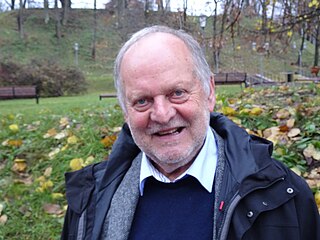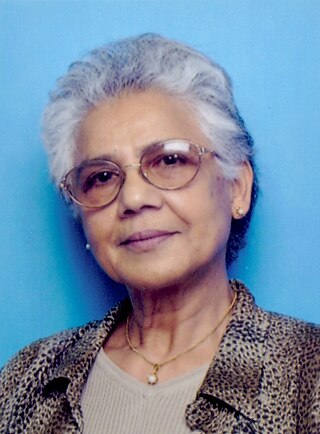
Michael Alexander Kirkwood Halliday was a British linguist who developed the internationally influential systemic functional linguistics (SFL) model of language. His grammatical descriptions go by the name of systemic functional grammar. Halliday described language as a semiotic system, "not in the sense of a system of signs, but a systemic resource for meaning". For Halliday, language was a "meaning potential"; by extension, he defined linguistics as the study of "how people exchange meanings by 'languaging'". Halliday described himself as a generalist, meaning that he tried "to look at language from every possible vantage point", and has described his work as "wander[ing] the highways and byways of language". But he said that "to the extent that I favoured any one angle, it was the social: language as the creature and creator of human society".

A sign is an object, quality, event, or entity whose presence or occurrence indicates the probable presence or occurrence of something else. A natural sign bears a causal relation to its object—for instance, thunder is a sign of storm, or medical symptoms a sign of disease. A conventional sign signifies by agreement, as a full stop signifies the end of a sentence; similarly the words and expressions of a language, as well as bodily gestures, can be regarded as signs, expressing particular meanings. The physical objects most commonly referred to as signs generally inform or instruct using written text, symbols, pictures or a combination of these.
Semiotics is the systematic study of sign processes (semiosis) and meaning-making. Semiosis is any activity, conduct, or process that involves signs, where a sign is defined as anything that communicates something, usually called a meaning, to the sign's interpreter. The meaning can be intentional, such as a word uttered with a specific meaning; or unintentional, such as a symptom being a sign of a particular medical condition. Signs can also communicate feelings and may communicate internally or through any of the senses: visual, auditory, tactile, olfactory, or gustatory (taste). Contemporary semiotics is a branch of science that studies meaning-making and various types of knowledge.

Systemic functional grammar (SFG) is a form of grammatical description originated by Michael Halliday. It is part of a social semiotic approach to language called systemic functional linguistics. In these two terms, systemic refers to the view of language as "a network of systems, or interrelated sets of options for making meaning"; functional refers to Halliday's view that language is as it is because of what it has evolved to do. Thus, what he refers to as the multidimensional architecture of language "reflects the multidimensional nature of human experience and interpersonal relations."
Semiosis, or sign process, is any form of activity, conduct, or process that involves signs, including the production of meaning. A sign is anything that communicates a meaning, that is not the sign itself, to the interpreter of the sign. The meaning can be intentional such as a word uttered with a specific meaning, or unintentional, such as a symptom being a sign of a particular medical condition. Signs can communicate through any of the senses, visual, auditory, tactile, olfactory, or taste.
In semiotics, a sign is anything that communicates a meaning that is not the sign itself to the interpreter of the sign. The meaning can be intentional, as when a word is uttered with a specific meaning, or unintentional, as when a symptom is taken as a sign of a particular medical condition. Signs can communicate through any of the senses, visual, auditory, tactile, olfactory, or taste.

Systemic functional linguistics (SFL) is an approach to linguistics, among functional linguistics, that considers language as a social semiotic system.
In semiotics, the value of a sign depends on its position and relations in the system of signification and upon the particular codes being used.

Representation is the use of signs that stand in for and take the place of something else. It is through representation that people organize the world and reality through the act of naming its elements. Signs are arranged in order to form semantic constructions and express relations.

Gunther Rolf Kress MBE was a linguist and semiotician. He is considered one of the leading theorists in critical discourse analysis, social semiotics and multimodality, particularly in relation to their educational implications. Kress has been described as "one of the leading academics of the early 21st century".
Visual semiotics is a sub-domain of semiotics that analyses the way visual images communicate a message.
The study and practice of visual rhetoric took a more prominent role in the field of composition studies towards the end of the twentieth century and onward. Proponents of its inclusion in composition typically point to the increasingly visual nature of society, and the increasing presence of visual texts. Literacy, they argue, can no longer be limited only to written text and must also include an understanding of the visual.

Ruqaiya Hasan was a professor of linguistics who held visiting positions and taught at various universities in England. Her last appointment was at Macquarie University in Sydney, from which she retired as emeritus professor in 1994. Throughout her career she researched and published widely in the areas of verbal art, culture, context and text, text and texture, lexicogrammar and semantic variation. The latter involved the devising of extensive semantic system networks for the analysis of meaning in naturally occurring dialogues.

James Robert Martin is a Canadian linguist. He is Professor of Linguistics at The University of Sydney. He is the leading figure in the 'Sydney School' of systemic functional linguistics. Martin is well known for his work on discourse analysis, genre, appraisal, multimodality and educational linguistics.
The term metafunction originates in systemic functional linguistics and is considered to be a property of all languages. Systemic functional linguistics is functional and semantic rather than formal and syntactic in its orientation. As a functional linguistic theory, it claims that both the emergence of grammar and the particular forms that grammars take should be explained "in terms of the functions that language evolved to serve". While languages vary in how and what they do, and what humans do with them in the contexts of human cultural practice, all languages are considered to be shaped and organised in relation to three functions, or metafunctions. Michael Halliday, the founder of systemic functional linguistics, calls these three functions the ideational, interpersonal, and textual. The ideational function is further divided into the experiential and logical.
The following outline is provided as an overview of and topical guide to semiotics:

Multimodality is the application of multiple literacies within one medium. Multiple literacies or "modes" contribute to an audience's understanding of a composition. Everything from the placement of images to the organization of the content to the method of delivery creates meaning. This is the result of a shift from isolated text being relied on as the primary source of communication, to the image being utilized more frequently in the digital age. Multimodality describes communication practices in terms of the textual, aural, linguistic, spatial, and visual resources used to compose messages.
The semiotics of fashion is the study of fashion and how humans signify specific social and cultural positions through dress. Ferdinand de Saussure defined semiotics as "the science of the life of signs in society". Semiotics is the study of signs and just as we can interpret signs and construct meaning from text we can also construct meaning from visual images such as fashion. Fashion is a language of signs that non-verbally converse meanings about individuals and groups. It holds a symbolic and communicative role having the capacity to express one's unique style, identity, profession, social status, and gender or group affiliation.
The kineikonic mode is a term for the moving image as a multimodal form. It indicates an approach to the analysis of film, video, television and any instance of moving image media that examines how systems of signification such as image, speech, dramatic action, music and other communicative processes work together to create meaning within the spatial and temporal frames of filming and editing.

Written in 2003, and published by Taylor & Francis Group, Gunther Kress' book Literacy in the New Media Age explores how the introduction of modern technology has impacted the way individuals interact with their culture through written and oral communication. Expanding upon the idea of the evolution of media and writing in a digital medium, Kress looks at the impacts of media communications on societies and cultures and vice versa.







